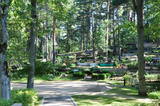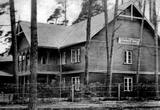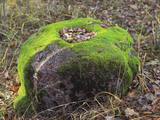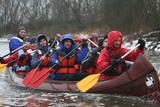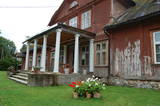| Нo | Название | Описание |
|---|---|---|
|
Кладбище на этом месте (Сигули) существует уже с 1773-го года. На Царникавском кладбище покоится выдающийся народный поэт Оярс Вациетис (1933 – 1983), где ему поставлен памятник. Можно также осмотреть каплицу Царникавского имения, построенную в 18-м веке и надгробие арендатора имения Фалка. |
||
|
Atrodas Grobiņas centrā, Dzērves laukuma malā. Pirmā baznīca Grobiņa bija celta jau ap 1560. g., bet nākamā – 1596. g. celtā iznīcināta 1659. g. zviedru iebrukuma laikā. Pēc Kurzemes un Zemgales hercoga Jēkaba Ketlera iniciatīvas 1664. g. tiek uzcelts jauns dievnams, ko atjauno 1892. gadā. Tas dedzis 2. pasaules kara laikā, bet vēlāk atkal atjaunots. Šobrīd notiek altāra restaurācijas darbi. |
||
|
Комплекс „Странд” был самым большим и роскошным в Нейбаде. Он состоял из трех зданий, павильона для танцев и парка. До настоящего времени сохранилось только здание отеля, где была устроена скорая медицинская помощь Саулкрасты – по адресу ул.Айнажу 17. |
||
|
Памятник природы - охраняемые дендрологические насаждения «Парк Варкавас» - расположен в Упмальской волости, и его площадь составляет 2,7 га, является охраняемым с 2001 года; территорией управляет Варкавский областной совет. Парк был разбит в конце 19-го века, судя по самым большим дубам (приблизительно 200-летним), остальные насаждения были проведены в конце 19-го века. В парке растут местные сорта кустарников и деревьев - клены, ясени, ели, осины, дубы, нежная ива, липы, вязы, лещина, бересклет европейский, черемуха и др., а также более 10 экзотических видов деревьев и кустарников, наиболее значимые из которых - клен остролистный, клен сахарный, чубушник пушистый, душистая осина, серебряная ива, Венгерская сирень, Крымская липа, липа широколиственная. |
||
|
Pirmo reizi vēstures avotos 1253. g. šī vieta ir minēta kā kuršu apdzīvota apmetne. Laikā no 1637. – 1639. g. te uzcēla pirmās 19 kapelas – t.s. „Krusta ceļa stacijas", kas atgādināja Jeruzalemes Krusta ceļu. Kopš tā laika Žemaišu Kalvarija ir pazīstama kā nozīmīgs svētceļnieku galamērķis. Dažas no Krusta ceļa kapelām ir veidotas 17. – 18 gs., bet citas – 19. gs. Jāatceras, ka vēl pavisam nesen – Padomju laikos svētceļniekus nežēlīgi vajāja un represēja. Mūsdienās pilsētā ir izveidots 21 svētceļnieku „pieturas punkts". Te ik gadu (parasti no 2. – 12. jūlijam) notiek Žemaišu Kalvarijas katoļu draudzes svētki, kas pulcina daudz ļaužu no dažādām Eiropas valstīm. Iespaidīgā katoļu bazilika ir slavena ar Vissvētākās Jaunavas Marijas Katoļu Ģimeņu Karalienes gleznu, kas 17. gs. atvesta no Romas. Tai piedēvē brīnumdarītājas spējas. Interesants ir pilsētas ielu tīklojums, kas atgādina 9. – 13. gs. apdzīvotas vietas ielu plānojumu. Noteikti apskatāms iespaidīgais Žemaišu Kalvarijas pilskalns, kas slejas mazās Varduvas (Varduva) upītes krastā. |
||
|
Piedāvājumā relaksācija pirtī - sildīšanās, skrubēšanās, enerģiskais pēriens, kā arī dažādas masāžas. |
||
|
История Лигатне неразрывно связана с Лигатненской бумажной фабрикой. В конце XIX начале XX столетия здесь построили дома для рабочих, школу, роддом, больницу, клуб, гостевой дом и другие здания, которые сохранились и по сей день. В советское время Лигатненская бумажная фабрика выпускала, главным образом, школьные тетради, по которым учились во всех республиках СССР. В наши дни главным сырьем является макулатура, из которой производится упаковочная бумага. Лигатненская бумажная фабрика является единственным функционирующим в Латвии подобного рода предприятием. Ознакомиться с производством можно в сопровождении местного гида. Историческому центру Лигатненской бумажной фабрики присвоен статус памятника культуры. В северной части Лигатне, в Гауясмале, определенно следует побывать на единственной функционирующей в наши дни и единственной речной переправе в Балтии - переправе Гауяс, которая работает на силе течения. Переправа – это транспортное средство местного масштаба. К западу от Лигатне находятся Лигатненские природные тропы, где в приближенных к естественной среде условиях (лучший объект такого рода в Балтии) живут благородные олени, косули, кабаны, лисы и рыси. На территории Лигатненских природных троп создана плотная сеть прогулочных троп и асфальтированный авто – веломаршрут, которая зимой превращается в трассу для катания на дистанционных лыжах. Здесь расположен современный центр для посетителей. К востоку от Лигатне, в реабилитационном центре «Лигатне» находится уникальное в масштабе Европы место - бывший секретный бункер советских времен, который был построен как место работы и проживания главный высших военных и гражданских лиц на случай применения ядерного или химического оружия. Бункер был обнаружен в 2003 году, поэтому до наших дней он сохранился в первозданном виде. По дороге из Аугшлигатне в Лигатне следует посетить парк Виенкочу (парк Колод), где можно увидеть созданные скульптором Рихардом Высоцким скульптуры их деревянных колод, осмотреть макеты всевозможных зданий, дом Песка, а также поучаствовать в тематических мероприятиях. |
||
|
Atrodas Rīgas – Ventspils autoceļa (A 10) 88. kilometrā, pašā Abavas krastā. Pie stāvlaukuma interesants objekts – senais Zemgales un Kurzemes robežstabs un vēsturisko novadu robeža. Piedāvā kempinga pakalpojumus. |
||
|
Taka ved cauri mežam uz skatu torni purva malā. Takā apskatāma Nāzara priede –priede, pie kuras 1905. gadā nošauts dumpinieks, pati priede – ekoloģiskais koks ar dzilnu kaltiem dobumiem, nokaltusi. Melnalkšņu dumbrājs - slīkšņa ar cūkaušiem un puplakšiem. Oleru purvs no skatu torņa – pārejas un sūnu purvs, kas izveidojies nolaista ezera vietā. Papildus objekti blakus takai, pieejami pa ceļu – Oleru muižas komplekss, Krustakmens, Oleru muižas kapi. Kopējais takas garums: 1,1 km. |
||
|
Уникальный объект индустриального наследия – единственный открытый завод по производству амуниции в странах Балтии, на территории которого находится самая старая дроболитейная башня в Европе, которая до сих пор используется по назначению. Группы туристов по предварительной договоренности в сопровождении гида могут осмотреть производство, дроболитейную башню и музей. Сейчас на дроболитейном заводе производят пули девяти видов для гладкоствольного оружия, а также пули для пневматического оружия. Продукция экспортируется в соседние страны, Германию и другие страны. |
||
|
Зиленский жертвенный камень. В деревне Зеленополе, около
крутого склона Золотого холма, можно осмотреть камень с кольце-
образным углублением посередине – Зиленский жертвенный
камень. Это было культовое место, где приносили жертвы богам,
очищались от дурного и набирались светлой энергии.
|
||
|
Памятный знак Стабурагсу «Ухо бога» скульптора Солвейги Васильевой был установлен в 2003-м году в парке Виганте на месте, где после образования водохранилища Плявиньской ГЭС был затоплен один из интереснейших геологических памятников природы Латвии. Овитый сказаниями, легендами и рассказами плотовщиков, Стабурагс представлял собой известняковый утес высотой 18,5 метров на левом берегу Даугавского каньона, образовавшегося после последнего ледникового периода. Из скалы Стабурагс вытекал источник Лиепавотс, который тоже был затоплен. Стабурагс и затопленный каньон Даугавы были одними из популярнейших туристических объектов Латвии. |
||
|
Компания занимается организацией природных походов: летом морские походы на байдарке, осенью на болотоступах по болоту, зимой походы на снегоступах и весной на каноэ по рекам. |
||
|
Музей расположен в здании мызы Ууэ-Варбла. Экспозиция отражает местный уклад жизни в первой половине прошлого столетия и историю волости Варбла. В музее есть и мастерская. В зерновом амбаре мызы Вы сможете познакомиться со старинными ручными инструментами и машинами. Особой достопримечательностью является возведённое в 1797 году основное деревянное здание мызы в стиле раннего классицизма.Традиционным мероприятием является организуемая в июле ярмарка ремесел. |
||
|
Кафе находится в Екабпилсе на обочине Екабпилсской окружной дороги (A6), на правом берегу Даугавы. Латышская кухня: Холодный суп, домашние котлеты, тонкие блины. |
||
|
Находится в южной части города, на улице Синицина, 4. Храм построен в 1895 г., а в 1906 г. перестроен. На колокольне находится три литых из серебра и меди колокола (отреставрированные), один из которых является самым тяжелым в странах Балтии ( вес 4832 кг, язык колокола весит 200 кг)! Рядом расположен музей, который знакомит с культурной средой старообрядцев и церковной жизнью. |
||
|
Красивый, гармоничный и, конечно же, неповторимый - таким в двух словах является cад дома «Гундегас» Даудзевской волости. Хозяйка Агрита Лайзане посвящает ему большую часть своего дня, и больше всего заботы ее детищу требуется весной, когда вдохновленная, она сеет, пикирует, сажает, и осенью – планирует работы на следующий год, собирает семена, готовит сад к зиме. |
||
|
This is the thickest English oak (Quercus robur) in Lithuania, with a circumference of 9.4 m (as opposed to the Kaive oak in Latvia, which has a circumference of 10.18 m).
|
||
|
Суйты - одна из самых ярких, разнообразными культурными традициями богатых общин в Курземе и в Латвии. Доказательством этому служит факт, что 1 октября 2009 года Культурное пространство Суйтов было включено в Список всемирного нематериального наследия ЮНЕСКО, которое требует срочного спасения. Культурное пространство Суйтов включено также в список народных традиций Латвийских канонов культуры. Проявления, характеризующие нематериальное Культурное наследие Суйтов - традиционные праздники, народные обычаи, устная традиция, традиционное пение и музыкальные навыки, традиционные народные костюмы и кулинарные традиции. С 2009 года община Суйтов переживает ренессанс, а это означает, что часть общины проводит активные действия по сохранению традиций, обеспечению жизнеспособности и их подвижению на местном, национальном и на международном уровне. Жизнеспособность Культурного пространства Суйтов находится в руках представителей общины, так как основывается на практическом применении и креативности представителей общины. Суйты считают развитие туризма в своем культурном пространстве одной из важных областей развития самого культурного пространства. В частности, подчеркивая нишу культурного туризма, основанную на продвижении уникального Культурного наследия Суйтов в более широком масштабе. |
||
|
Предлагаются прогулки верхом по живописным лесам и индивидуальные занятия по верховой езде. |
||
